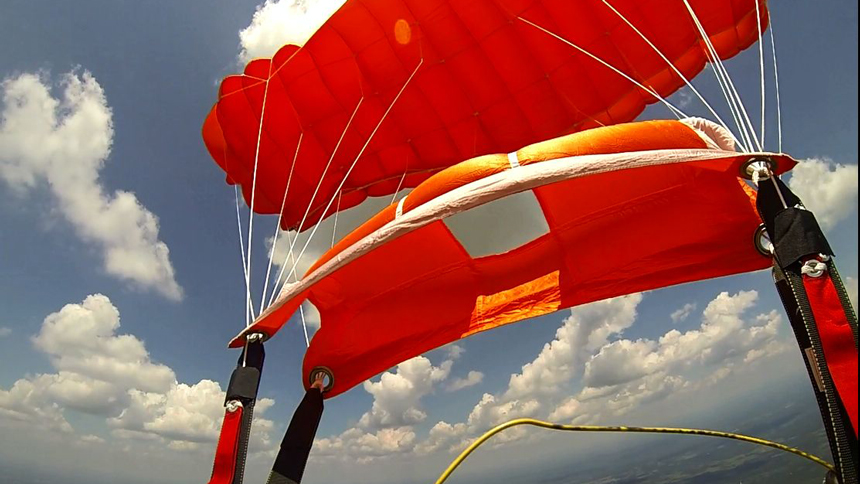
There you are at work Friday afternoon, imagining the weekend ahead at the DZ. You get off work early, leaving a few last minute projects unattended, load up the car and off you go… 🙂 Unfortunately a little too quickly and you end up getting flashed by a speed camera! Hectic drive with busy head… Phew, finally at the DZ and put your name on manifest and get straight onto a 5 minute call. Super quick briefing inside the aircraft and, as the most experienced onboard, you end up as the load master… Doh, exit funnelled, finally get the group together halfway through the dive and rush through a few moves, levels are off at the end of the jump, which makes for a confusing break-off, also the batteries on your audible faded. However you manage a long track to get away from the chaos…
Oops, open a wee bit low. A 180 on deployment, finally get things sorted and bust out a few big spirals to get lower than the rest of the group, yahoo!… Ah, missed the first part of the landing circuit trying to avoid the traffic, a little too low for that last turn, jam the brakes down to dig out of the corner, woah, I didn’t realize that I could go that high with my canopy, ouch! .. ankle snaps loudly on landing.

This is a scenario Pete Allum used on the Speedfly Safety Roadshow, to illustrate many points made in part 1 of this article The 2 ways to Die.
There, he observed that the two most common ways to die in our sport are:
- Striking the ground hard after a manoeuvre made with too little time to recover.
- Colliding with a fellow skydiver in free fall or under canopy.
This second and final part of his article discusses how to avoid being in a collision, and concludes the wisdom of the Speedfly Tour. We also include 2 videos of (harmless) collisions to show how quickly incidents can occur.
Parachute collision after opening
Freefall & Canopy Collisions
Each type of jump that we do can have a different set of rules, so figure out the correct plan for the following areas…
Exit Separation
Check the rules in operation at the DZ you are jumping at. Time between groups: the only system that works is by leaving the correct time between groups depending upon the conditions. In order to have approximately 350m separation from one group to the next you would need to ask the pilot the groundspeed; knowing the groundspeed you would then look along the chart to get a number of seconds to leave in between groups. Some DZs have this simple chart in the aircraft. Others have a white board that they write the number of seconds between groups each day.
The big sky theory does not work for us; too many people who relied upon this theory are dead
Groundspeed & Minimum Separation
Pilot gives the groundspeed.
- 110-120 Knots = 6 seconds delay
- 100 Kts = 7 seconds
- 90 Kts = 8 seconds
- 80 Kts = 9 seconds
- 70 Kts = 10 seconds
- 60 Kts = 11-12 seconds
- 50 Kts = 13-15 seconds
- 40 Kts = 16-19 seconds
- 30 Kts = 20 seconds
Speed data available in graphical form from the author or Google
- Tracking plan and efficiency
Each type of jump and the size of group your tracking plan might change, you also need to be aware of other groups on your pass.
- Awareness and control throughout deployment
This is to help avoid malfunctions, canopy collisions and traffic.
- Practice avoidance techniques
Don’t wait until you have a canopy heading towards you on opening with a 40MPH closing speed to practice these skills.
- Fly defensively!
Be ready on every jump!

Air Traffic Control (traffic under canopy)
Exit order, this should be logical, sometimes there will be local variations on general policy.
- Constant Vigilance
The big sky theory does not work for us; too many people who relied upon this theory are dead. Watch for changes in conditions. Set up a traffic flow and fly a consistent pattern. Maintain vertical separation.
- Separate landing areas
Allocate different landing areas for various types of landing ie, students, regular 90° approaches, staff, high performance, etc.
- Adapt
Be ready to change your plan based on what is happening. You do not have the right to make a high speed, aggressive approach on every jump.
You do not have the right to make a high speed, aggressive approach on every jump
Landing priorities
The most important conditions for landing safely are, in priority order
- An area free of obstacles
- Canopy in full flight
- Wing level with ground
- Level flare
- Into wind, if possible
If you find you are low, react now! Be smart; better a crosswind or downwind landing than in a turn.
Emergencies
Think often about the various problems that can occur and ask questions of the people that know the answers. Practice or visualize your emergency procedures for:
- Aircraft emergencies (what are your altitudes?)
- Free Fall
- Break off
- Openings – off heading, collisions, etc.
- Under canopy
- Landing
- Turbulence
What conditions of turbulence are jumpable? This can radically change with higher winds from different directions.

Photo by Willy Boeykens
Conclusions
- Go out and practice – jump!
- Aim for more awareness of self and others
- Figure out how experienced you actually are in each discipline you practice
- Set yourself goals for each jump but be ready to adapt to the scenario
- Get to know your canopy
- We move in a high-speed, dangerous environment, keep your eyes open
- Learn from your mistakes and the mistakes of others
- Keep learning
Don’t miss the first part of this article by Pete Allum!!!


